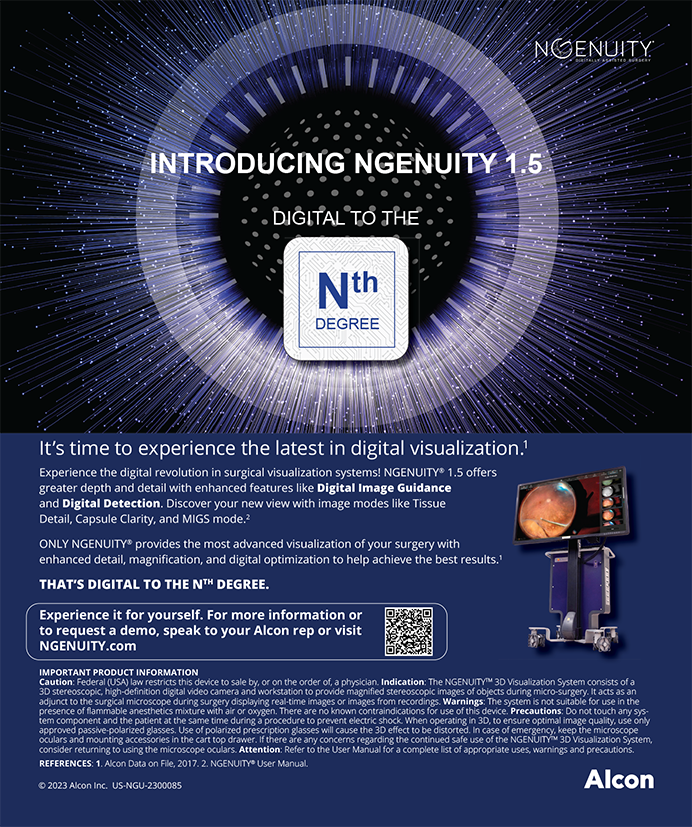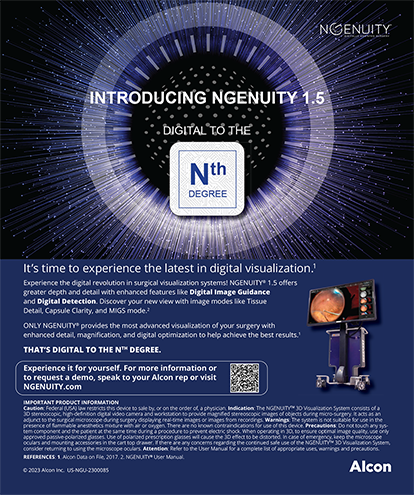The Lenstar LS900 (Haag-Streit AG) represents the newest generation of optical biometers (Figure). I have found that this instrument increases the refractive accuracy of cataract surgical outcomes, especially with premium IOLs.
AXIAL MEASUREMENTS
Using optical biometry, the Lenstar segments the eye into three sections (cornea and aqueous, lens, and posterior segment). The instrument not only provides accurate measurements of the axial length but also the central corneal thickness, anterior chamber depth (ACD), and thickness of the lens. Precise calculations of the ACD and lens thickness are a requirement of later-generation theoretical formulas such as Holladay 2 and Olsen. For future generations of IOL power calculation methodologies and also those that may employ advanced ray tracing and engineering-based statistical models, an exact measurement of the ACD and thickness of the lens will be critical.
KERATOMETRY
To me, the autokeratometry feature of the Lenstar is one of its strongest features. The spherical equivalent of its keratometry readings (Ks) is basically the same as those of the IOLMaster (Carl Zeiss Meditec, Inc.), but that is where similarities end.1 Measuring two rings of 16 measurements each at 1.65 mm and 2.3 mm, the Lenstar carries out a total of 32 measurements spaced 22.5º apart. The greatest distance that any meridian can be located from a measurement light-emitting diode is approximately 11º. This renders the Ks for the Lenstar highly accurate for both the determination of the steep and the flat meridians and also the difference in power between them—a quality that makes this instrument especially useful for toric IOLs. The device's Ks have been demonstrated to be equivalent to manual keratometry for use with a toric IOL.2 The Lenstar's Ks may also be used with the ASCRS online postkeratorefractive surgery IOL power calculator.3
VALIDATION
One feature of this optical biometer that I particularly like is that its easy-tounderstand format allows me to scrutinize, validate, and (if necessary) adjust each measurement to achieve a clear endpoint. The axial measurements are displayed in the familiar format of an immersion A-scan. I can also directly view the quality of the reflected images from the cornea for keratometry, and each measurement can be deleted and/or repeated if need be. In addition, I can use a photographic image of the eye to adjust the horizontal corneal diameter and the pupillary diameter.
A number is only as good as the interpreter's ability to understand its meaning. At the end of the examination, the operator has no doubt about the overall accuracy of the exercise, because he or she can effectively validate every measurement.
FLEXIBILITY IN MEASUREMENTS
The Lenstar's computer and measurement head are separate, connected only by a simple USB cable. Third-party software containing more recentgeneration formulas (eg, Holladay IOL Consultant [Holladay Consulting, Inc.] or PhacoOptics software [IOL Innovations Aps]) can reside on the Lenstar's computer and be autopopulated by the Lenstar's software. This obviates the need for manual data entry or the use of cumbersome network transfers, which makes an error in transcription a thing of the past. The device's computer is a regular stand-alone Windows 7 computer (Microsoft Corporation), which maintains the patient database indefinitely.
LENS CONSTANTS
Two studies have demonstrated that the mean difference between the Lenstar's Ks and measurements of axial length and ACD and those of the IOLMaster are clinically insignificant.1,4 The lens constants previously optimized for the IOLMaster therefore can be used as a starting point for the Lenstar, with surgeons' individual optimization to follow.
ERGONOMICS
With each push of a button, the Lenstar takes seven measurements: axial length, Ks, central corneal thickness, ACD, thickness of the lens, horizontal corneal diameter, and pupillary diameter. The unit's most recent software version i4000 has doubled the speed of acquisition so that this process, including positioning and alignment of the patient for a single push of the button, takes between 10 and 20 seconds. The time required of the patient is thus relatively short. Five pushes of the button are recommended for measuring each patient, which requires approximately 2 to 3 minutes on average.
SUMMARY
The only possible downside to the Lenstar is that it requires the user to be a little more sophisticated and to think about what he or she is doing. Rather than just produce numbers, the instrument provides an easy-tounderstand representation of the way in which the measurements were obtained, with operator-adjusted electronic calipers. At the end of every examination, the user can confirm that the measurements are correct.
The bottom line is that there is no uncertainty about accuracy. In my experience, refractive outcomes are better, especially with one of the newergeneration IOL power calculation formulas such as Haigis, Olsen, or Holladay 2. I have found the Lenstar to be an indispensible part of my cataract and anterior segment refractive practice.
Warren E. Hill, MD, is the medical director of East Valley Ophthalmology in Mesa, Arizona. He is a consultant to Alcon Laboratories, Inc., and Haag-Streit AG. Dr. Hill may be reached at (480) 981-6111; hill@doctor-hill.com.


